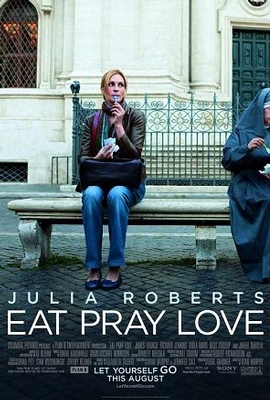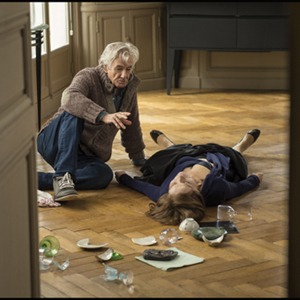 I have a confession to make. This review will actually address only 95 per cent of Eat Pray Love, as the first 5 per cent was spent sitting in the lobby of the Odeon in Leicester Square, waiting for my companion, who was late. I could, of course, have caught a screening by myself, which is how I usually go about this sort of thing. That way, I would have ensured that I saw the whole thing. On this occasion, however, I thought it wise to invite someone along, that someone being mid-twenties, female, and an avid Sex and the City fan (I have it on good authority that she has a cocktail glass with “Carrie” emblazoned across it). The invitation was not a cheap trick on my part – rather, I wanted to sit next to someone who was actually expecting to enjoy Eat Pray Love. As it happens, she didn’t. She did, however, make the wait worthwhile. For, near the start of the movie, as Liz (Julia Roberts) gets into a car and drives away from her Upper West Side Brownstone town house, my companion whispered “that’s just like Carrie’s house!” (no, not the white picket fence and the hand through the garden lawn, the other Carrie). And that’s what it comes down to. That comparison is the key to understanding the wider significance of Eat Pray Love.
I have a confession to make. This review will actually address only 95 per cent of Eat Pray Love, as the first 5 per cent was spent sitting in the lobby of the Odeon in Leicester Square, waiting for my companion, who was late. I could, of course, have caught a screening by myself, which is how I usually go about this sort of thing. That way, I would have ensured that I saw the whole thing. On this occasion, however, I thought it wise to invite someone along, that someone being mid-twenties, female, and an avid Sex and the City fan (I have it on good authority that she has a cocktail glass with “Carrie” emblazoned across it). The invitation was not a cheap trick on my part – rather, I wanted to sit next to someone who was actually expecting to enjoy Eat Pray Love. As it happens, she didn’t. She did, however, make the wait worthwhile. For, near the start of the movie, as Liz (Julia Roberts) gets into a car and drives away from her Upper West Side Brownstone town house, my companion whispered “that’s just like Carrie’s house!” (no, not the white picket fence and the hand through the garden lawn, the other Carrie). And that’s what it comes down to. That comparison is the key to understanding the wider significance of Eat Pray Love.
Liz, apparently, lives in a house just like Carrie Bradshaw. Which means she has Money, with a capital “M”. And we can surmise from the book on which the film is based that the real Elizabeth Gilbert had access to similar funds (in this case, I believe, the advance on said book) that would allow her to drop out for a year and make her way across Italy, India and Indonesia. So, clearly, Penguin had the cash to gamble on Gilbert’s title being a bestseller (it was), thus leading the way for film’s producers (Brad Pitt among them) to make a slightly less risky gamble that Eat Pray Love might turn a profit for them (it is doing so). Now that they have the dollar being churned by this behemoth, perhaps they can afford to take some time out, too. For, at the heart of Eat Pray Love is a churning, cyclical bind: “go”, it says to you. Go and Discover Yourself. “LET YOURSELF GO”, as the poster puts it. “But,” reads the invisible condition, “only if you have the money, the status, the security and the assurance that you’ll be back in your Manhattan apartment in a year’s time.” So this perverse formula (money + discontent = self discovery) has played out in physical actuality, across the bookshops and boardrooms of New York and Los Angeles, and the product is Eat Pray Love, a fascinating totem of an engorged culture.
Every element of Eat Pray Love, down to a single note on the film’s score, is worthy of comment. It’s a fascinating, jaw-droppingly crafted film that, as a result of its bastard origins, gives unique insight into Hollywood, the movies, and their influence. First of all we’ve got the locations. There’s probably as much insight into real places in this movie as there was into life in North African towns in Casablanca (1942). Their excuse was, probably, that they were filming on a backlot in 1940s California. By comparison, when we travel to Rome in Eat Pray Love, we’re greeted with gesticulating Italians, pizza, pasta, and a soundtrack seemingly inspired by the Rosemary Clooney hit, “Mambo Italiano” (she also had a big success with her rendition of “Hooray for Hollywood”). India and Bali are similarly full of sitars and paddy fields, respectively. Not since the 1960s have we been presented with a film so brazenly acting as a surrogate vacation, tailored to all the exact and precise specifications that an audience would expect from somewhere not in Middle America. It’s scary to see what one might hope to be dying conceptions of “over there” reinforced with such vigour.
The formal construction of the movie is, also, amazing. It is, I would argue, not dissimilar in its make-up to an action movie (it’s worth noting that, on its debut, Eat Pray Love jostled briefly with the Stallone vanity project The Expendables for a Number One slot; a his ‘n’ hers double team at the top of the charts). Here, close-ups of explosions and dismemberments are swapped almost wholesale for close-ups of food preparation and delicious consumption (deep, deep, we travel into the gullet of Roberts). Pizza, pasta, curry are all depicted in glorious HD (nobody knows what they eat in Bali, so that’s left out). The music swells, battering our emotions into submission, and the light from the sky and through windows blooms, bleaching out the corners of the screen. The film is, thus, a full-on experience in an unreal world, in which the very architecture and make-up of the spaces through which Roberts travels seem all to be engraved with the words: “this is how you feel now”.
So Roberts travels, and she travels, but nothing actually happens. Eat Pray Love is a long movie, but you’re left with the feeling that it could have been much, much longer. Director Ryan Murphy (also behind Glee) likely shot double the amount of material seen here and pared it down to its shortest possible form, that being almost two and a half hours. But this is a two-and-a-half-hour montage, a two-and-a-half-hour advert, which brings to light the reality of what modern video and film advertisements really are: emotional pornography. The problem is, when we’re exposed to 30 seconds of Marks and Spencer or Vodaphone, the effect is irritating, but passing. When this type of construction is expanded (not stretched, but magnified) to take up two and a half hours, during which you’re trapped, staring at the enormous head of Javier Bardem, the effect is mind-numbing. We go from money-shot of pasta eating to deep personal revelation to Javier crying, constantly. And it makes you want to cry, too. This is not, however, the sort of responsive cinematic crying that you might experience when Philip Seymour Hoffman sheds a tear at the end of Magnolia (1998), and you cry too because there’s a rush of insight into how he’s been holding it all in throughout the film. This is cinematic crying of the “I want to go home, I want to curl up in my bed” variety, that you might hear emanating from an overly brave 12 year old who has snuck into a late screening of Saw V.
Eat Pray Love has more in common with David Cronenberg’s The Fly (1986) than you might imagine. There, Jeff Goldblum’s DNA gets crossed with that of a housefly, with horrific results. There’s a similar kind of unholy union here. Eat Pray Love is a film ostensibly concerned with a personal, philosophical quest. This is, I imagine, ideally suited to the format of a book, the reading of which is a singular, non-linear experience. This, perhaps, accounts for some of Gilbert’s large success. In the cinema, however, the writer’s voice is gone, as is the individuality of the consumer. Here, we’re surrounded by 60 other people. Much has been written about the communal experience of cinema. About how, when we’re watching E.T. (1982) in the theatre and not on TV, we’re more likely to have the hairs on our necks stand up when Eliot’s bike floats above the police blockade because we’re all experiencing it together. But this is a fine line. And Eat Pray Love is a film in which the opposite occurs: the viewer is physically and uncomfortably embarrassed to be amongst other people who know that the viewer is watching the same thing that they are. This is because what we see in Eat Pray Love is a depiction of some of our darkest, innermost knowledge. This should never happen. It’s a depiction of what we know to be a perverse, Hollywood-ized representation of broken life of the worst kind, the sort of cliché that we would recognise in our minds but never be able to find the words to express accurately. And I don’t think it’s the skill of the director or writers through which this has been achieved. Rather, it’s the natural result of a kind of incest; that which occurs when Liz Gilbert’s real life experience, essentially a Hollywood experience (take your riches and fund the “me” quest, the ultimate in selfish destruction) is fed back through the dream machine, to create a hyper-real, concentrated picture of life lived through a lens of rich, Western condescension.

